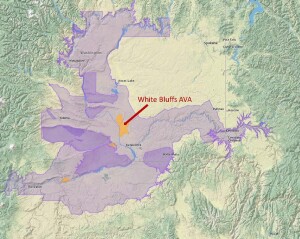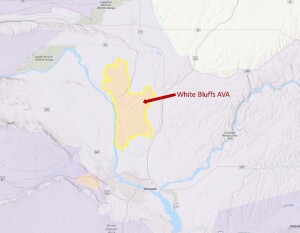On June 17, 2021, the TTB (Alcohol and Tobacco Tax and Trade Bureau) of the United States approved two new American Viticultural Areas (AVAs): the White Bluffs AVA and the Burn of Columbia Valley AVA. When these new AVAs come into force—on July 19, 2021—the total number of AVAs in Washington State will be 18.
This article will focus on the White Bluffs AVA; click here for an article focusing on the Burn of Columbia Valley AVA.
The White Bluffs AVA—named for a steep escarpment located along the eastern shore of the Columbia River—is located with Franklin County, about 10 miles/16 km north of the town of Kennewick. The White Bluffs AVA is a sub-region of the much larger Columbia Valley AVA.
The defining characteristics of the White Bluffs AVA include the area’s topography, soils, and climate. These features—as noted by Dr. Kevin Pogue, Professor of Geology at Whitman College and the author of the original petition—are discussed below.
Topography: The White Bluffs AVA sits atop an elevated plateau, as much as 200 feet/61 meters above the surrounding area (known as the Pasco Basin). As a result, the overall elevation of the region varies between 800 feet/244 meters and 1,000 feet/305 meters above sea level. The plateau is divided by the Ringold Coulee and the Koontz Coulee into two relatively flat areas known as the Columbia Flat and the Owens Flat. In addition, the southern edge of the appellation includes a portion of the south-facing slopes of the namesake White Bluffs.
Soils: The topsoil of the area—windblown silt (loess) and alluvial deposits from the Missoula floods—is quite similar to the soils in the surrounding areas. However, what lies beneath—a layer of ancient lakebed sediment with a whitish appearance topped by a layer of caliche (calcium carbonate)—is unique. This layer—known as the Ringold Formation—also contains enough clay so that the soil retains different proportions of water and minerals (as compared to those of the surrounding areas). In addition, the Ringold Formation is deep enough so that the roots of the vines planted in the White Bluffs AVA—unlike the vines in much of the rest of the Columbia Valley AVA—do not ever reach the basalt bedrock.
Climate: Due to the added elevation, the area within the White Bluffs AVA is protected from the cold air on the surrounding valley floor. This makes for a slightly warmer temperature and longer growing season, as compared with the surrounding area. Vines have been planted in the area since 1972 and have never experienced a freeze during the growing season.
The White Bluffs AVA covers a total of 93,738 total acres (146 square miles), with 1,127 acres/456 ha planted to vines. Currently, there are nine commercial vineyards and one bonded winery—Claar Cellars—located within the boundaries of the appellation. The leading grape varieties include Cabernet Sauvignon, Merlot, Syrah, Riesling, and Sauvignon Blanc.
Welcome to the world, White Bluffs AVA!
P.S. The TTB has also announced a new AVA in California—Palos Verdes Peninsula—to be effective on July 19, 2021. Click here for more details.
References/for more information:
- Original Petition to Establish the White Bluffs AVA
- TTB Ruling – Establishment of the White Bluffs AVA
- Maps of the White Bluff AVA via the TTB-AVA Proposal
- Washington State Wine (washingtonwine.org)
Post authored by Jane A. Nickles…your blog administrator: jnickles@societyofwineeducators.org

